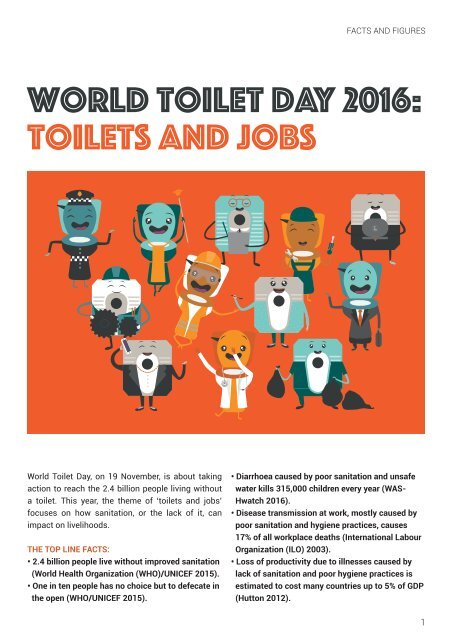World Toilet Day 2016 Toilets and jobs
YGQ2306jVpm
YGQ2306jVpm
Create successful ePaper yourself
Turn your PDF publications into a flip-book with our unique Google optimized e-Paper software.
FACTS AND FIGURES<br />
<strong>World</strong> <strong>Toilet</strong> <strong>Day</strong> <strong>2016</strong>:<br />
<strong>Toilet</strong>s <strong>and</strong> <strong>jobs</strong><br />
<strong>World</strong> <strong>Toilet</strong> <strong>Day</strong>, on 19 November, is about taking<br />
action to reach the 2.4 billion people living without<br />
a toilet. This year, the theme of ‘toilets <strong>and</strong> <strong>jobs</strong>’<br />
focuses on how sanitation, or the lack of it, can<br />
impact on livelihoods.<br />
THE TOP LINE FACTS:<br />
• 2.4 billion people live without improved sanitation<br />
(<strong>World</strong> Health Organization (WHO)/UNICEF 2015).<br />
• One in ten people has no choice but to defecate in<br />
the open (WHO/UNICEF 2015).<br />
• Diarrhoea caused by poor sanitation <strong>and</strong> unsafe<br />
water kills 315,000 children every year (WAS-<br />
Hwatch <strong>2016</strong>).<br />
• Disease transmission at work, mostly caused by<br />
poor sanitation <strong>and</strong> hygiene practices, causes<br />
17% of all workplace deaths (International Labour<br />
Organization (ILO) 2003).<br />
• Loss of productivity due to illnesses caused by<br />
lack of sanitation <strong>and</strong> poor hygiene practices is<br />
estimated to cost many countries up to 5% of GDP<br />
(Hutton 2012).<br />
1
TOILETS HAVE THE POWER TO TRANSFORM<br />
ECONOMIES<br />
• Providing toilets to people in rural areas currently<br />
practising open defecation is estimated to result<br />
in benefits that exceed costs by between five <strong>and</strong><br />
seven times (Hutton 2015).<br />
• In India, the time spent looking for a toilet or finding<br />
somewhere to go in the open costs the economy<br />
over $10 billion every year in lost productivity – 20%<br />
of GDP (<strong>World</strong> Bank Group <strong>2016</strong>).<br />
• Diarrhoea caused by unsafe water, poor sanitation<br />
<strong>and</strong> hygiene is linked to 50% of child undernutrition,<br />
which can lead to stunted physical <strong>and</strong> mental<br />
development (WHO 2008).<br />
TOILETS IN THE WORKPLACE INCREASE<br />
PRODUCTIVITY<br />
• A lack of toilets at work <strong>and</strong> at home has severe<br />
impacts upon businesses through problems<br />
in the workforce: poor health, absenteeism,<br />
attrition, reduced concentration, exhaustion,<br />
<strong>and</strong> decreased productivity (Business for Social<br />
Responsibility (BSR) 2010).<br />
Access levels to toilets in the workplace reflects<br />
access levels to toilets in the home. Very little data<br />
exists to tell us how many workers don’t have access<br />
• Meeting the 2015 Millennium Development<br />
Goal target of 50% of people having access<br />
to sanitation <strong>and</strong> safe water was estimated<br />
to reduce sick days by 322 million every year,<br />
representing an annual health sector saving<br />
of $7 billion. (Stockholm International Water<br />
Institute (SIWI), 2005).<br />
• Globally, approximately $260 billion is lost each<br />
year to the effects of poor sanitation <strong>and</strong> unsafe<br />
water on many aspects of the economy, but<br />
most significantly on healthcare (Hutton 2012).<br />
2
to toilets, but, for instance, only 40% of the urban<br />
population in Sub-Saharan Africa has access to a<br />
domestic toilet (WHO/UNICEF 2015).<br />
Where toilets are present, a big issue for many workers<br />
is the way in which toilet breaks are controlled by the<br />
management. If access is restricted, people will hold<br />
back the urge to go, <strong>and</strong> even avoid food <strong>and</strong> drink<br />
to minimise how many times they might need to visit<br />
the toilet. Beyond the inconvenience <strong>and</strong> discomfort,<br />
this can have health impacts, particularly for women,<br />
leading to absenteeism <strong>and</strong> disease (BSR 2010).<br />
Loss of productivity due to illnesses caused by lack<br />
of sanitation <strong>and</strong> poor hygiene practices is estimated<br />
to cost many countries up to 5% of GDP (Hutton<br />
2012). In sectors such as the garment industry, the<br />
global workforce is 80% female (Business for Social<br />
Responsibility 2010). Investing in good toilets in<br />
workplaces <strong>and</strong> schools so that women <strong>and</strong> girls<br />
have clean, separate facilities to maintain their dignity,<br />
<strong>and</strong> to manage menstruation or pregnancy safely,<br />
can boost what is often referred to as the ‘girl effect’:<br />
maximising the involvement of half the population in<br />
society (Girl Effect 2015).<br />
• According to the International Labour Organization<br />
(2003), disease transmission accounts for<br />
approximately 17% of workplace deaths each year<br />
<strong>and</strong> most of these are a result of poor sanitation <strong>and</strong><br />
unsafe hygiene practices.<br />
• According to a study in the UK, sick days are<br />
estimated to cost companies a minimum of $117<br />
per person per day (Braun et al 2014).<br />
• In Vietnam, profitability was 7.6% higher in factories<br />
where workers expressed greater satisfaction with<br />
water, air quality, toilets, canteens <strong>and</strong> health services<br />
provided, holding other factors constant (ILO 2015).<br />
NOT EVERY TOILET IS A GOOD TOILET<br />
Anecdotal evidence from many low-income<br />
countries tells us that even when a toilet<br />
is physically present in the workplace, it<br />
doesn’t necessarily mean a person has<br />
access to safe, effective sanitation. We<br />
have to ask: are there sufficient numbers of<br />
toilets? Are they working, clean, lockable?<br />
Are there separate facilities for men <strong>and</strong><br />
women? Is there running water for people to<br />
wash their h<strong>and</strong>s or for women to manage<br />
menstruation safely?<br />
3
PROVIDING TOILETS AND OTHER SANITATION<br />
SERVICES CREATES JOBS<br />
The global dem<strong>and</strong> for water <strong>and</strong> sanitation services<br />
is worth over $50 billion (Freedonia 2013), so there is a<br />
massive dem<strong>and</strong> waiting to be met. Treating sanitation<br />
provision as a long-term business opportunity, as well<br />
as a fulfilment of people’s rights, could help speed up<br />
progress <strong>and</strong> attract investment.<br />
In the 2014 UN-Water Global Analysis <strong>and</strong> Assessment<br />
of Sanitation <strong>and</strong> Drinking-Water (GLAAS), less than<br />
20% of participating countries have sufficient capacity<br />
to meet rural sanitation needs <strong>and</strong> even fewer of<br />
these countries have plans in place to redress this<br />
gap (UN-Water, 2014), which requires investments<br />
in education, curriculum development, <strong>and</strong> enabling<br />
environments.<br />
Making it easy for people to set up sanitation<br />
businesses, as part of a bigger plan, will help<br />
entrepreneurs to flourish <strong>and</strong> could accelerate<br />
progress. Particularly in the towns <strong>and</strong> cities of lowincome<br />
countries, populations are growing fast <strong>and</strong><br />
their need for toilets <strong>and</strong> waste removal is already<br />
desperate. Small-scale service providers could play<br />
a vital role in getting toilets to people quickly <strong>and</strong><br />
beginning the transformation of slum areas (WaterAid<br />
<strong>2016</strong>).<br />
• In the EU, there are more than 2.5 million <strong>jobs</strong> in the<br />
wastewater <strong>and</strong> solid waste management sectors<br />
(Ernst <strong>and</strong> Young 2006).<br />
• The International Water Association (2014)<br />
assessed the capacity gap for trained water <strong>and</strong><br />
sanitation professionals to achieve universal water<br />
<strong>and</strong> sanitation access across 15 countries to be over<br />
750,000 individuals.<br />
REMOVING THE STIGMA FROM SANITATION<br />
WORK<br />
In 2013, new Indian legislation outlawed the<br />
building of any more insanitary toilets <strong>and</strong><br />
employing people as ‘manual scavengers’<br />
to clean out human faeces with their bare<br />
h<strong>and</strong>s from rudimentary latrines. The<br />
practice will take time to eradicate, but as<br />
sanitation improves in India, the government<br />
is rehabilitating manual scavengers,<br />
training them for alternative livelihoods <strong>and</strong><br />
providing education for their children (UN<br />
India 2014). Placing more value <strong>and</strong> respect<br />
for these tasks would also raise the workers’<br />
social status.<br />
4





